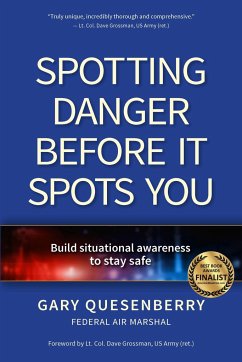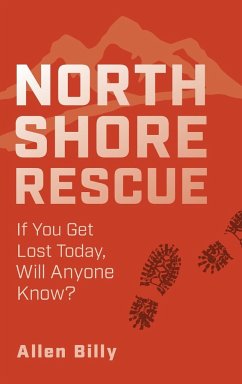27,99 €
inkl. MwSt.
Versandfertig in über 4 Wochen

14 °P sammeln
- Gebundenes Buch
- Merkliste
- Auf die Merkliste
- Bewerten Bewerten
- Teilen
- Produkt teilen
- Produkterinnerung
- Produkterinnerung
Continuing on the path of The Gift of Fear (Gavin deBecker),Spotting Danger Before It Spots You is the go-to guide for anyone wanting to improve their level of awareness and strengthen their personal defenses. This book will greatly improve your understanding of how, when and where violence occurs, providing you with the tools you need to properly identify and escape violent encounters before they can happen.
Andere Kunden interessierten sich auch für
![Gender-Based Violence in Children's Sport Gender-Based Violence in Children's Sport]() Gretchen KerrGender-Based Violence in Children's Sport175,99 €
Gretchen KerrGender-Based Violence in Children's Sport175,99 €![North Shore Rescue: If You Get Lost Today, Will Anyone Know? North Shore Rescue: If You Get Lost Today, Will Anyone Know?]() Allen BillyNorth Shore Rescue: If You Get Lost Today, Will Anyone Know?32,99 €
Allen BillyNorth Shore Rescue: If You Get Lost Today, Will Anyone Know?32,99 €![Understanding Animal Abuse and How to Intervene with Children and Young People Understanding Animal Abuse and How to Intervene with Children and Young People]() Understanding Animal Abuse and How to Intervene with Children and Young People174,99 €
Understanding Animal Abuse and How to Intervene with Children and Young People174,99 €![Maoists at the Hearth Maoists at the Hearth]() Judith PettigrewMaoists at the Hearth69,99 €
Judith PettigrewMaoists at the Hearth69,99 €![Sport as Social Policy Sport as Social Policy]() David EkholmSport as Social Policy177,99 €
David EkholmSport as Social Policy177,99 €![We Are Ukraine We Are Ukraine]() Maidan United IncWe Are Ukraine53,99 €
Maidan United IncWe Are Ukraine53,99 €![Popular Dissent, Human Agency and Global Politics Popular Dissent, Human Agency and Global Politics]() Roland BleikerPopular Dissent, Human Agency and Global Politics139,99 €
Roland BleikerPopular Dissent, Human Agency and Global Politics139,99 €-
-
-
Continuing on the path of The Gift of Fear (Gavin deBecker),Spotting Danger Before It Spots You is the go-to guide for anyone wanting to improve their level of awareness and strengthen their personal defenses. This book will greatly improve your understanding of how, when and where violence occurs, providing you with the tools you need to properly identify and escape violent encounters before they can happen.
Hinweis: Dieser Artikel kann nur an eine deutsche Lieferadresse ausgeliefert werden.
Hinweis: Dieser Artikel kann nur an eine deutsche Lieferadresse ausgeliefert werden.
Produktdetails
- Produktdetails
- Verlag: YMAA Publication Center
- Seitenzahl: 172
- Erscheinungstermin: 1. April 2022
- Englisch
- Abmessung: 234mm x 157mm x 17mm
- Gewicht: 390g
- ISBN-13: 9781594398711
- ISBN-10: 1594398712
- Artikelnr.: 63052598
- Herstellerkennzeichnung
- Libri GmbH
- Europaallee 1
- 36244 Bad Hersfeld
- gpsr@libri.de
- Verlag: YMAA Publication Center
- Seitenzahl: 172
- Erscheinungstermin: 1. April 2022
- Englisch
- Abmessung: 234mm x 157mm x 17mm
- Gewicht: 390g
- ISBN-13: 9781594398711
- ISBN-10: 1594398712
- Artikelnr.: 63052598
- Herstellerkennzeichnung
- Libri GmbH
- Europaallee 1
- 36244 Bad Hersfeld
- gpsr@libri.de
Gary Quesenberry is a US Army veteran and a career Federal Air Marshal. As a defensive tactics trainer for Federal and civilian services, he has devoted his life to studying the areas of violence and predatory behavior. Gary serves as the CEO of Quesenberry Personal Defense Training and has developed numerous basic and advanced level training courses focused on mental toughness, marksmanship, and defensive tactics. As a competitive pistol shooter, Gary has been featured on the History Channel's hit television series Top Shot - Season 3 and Top Shot All-Stars. He has an extensive background in domestic and foreign counter-terror training and has worked in both the private and corporate sectors to help educate others on the importance of situational awareness, and personal safety. Gary resides in Galloway, New Jersey.
ACKNOWLEDGMENTS
FOREWORD
INTRODUCTION
PHASE ONE - Understand the threat
Chapter 1: The basics of predatory behavior
* 1.1 How predators choose their targets - The seven-second PROD
* 1.2 Perception
* 1.3 Risk
* 1.4 Observable value
* 1.5 Defenses
* 1.6 Think Like a Predator
* Situational Awareness in Action: The Foiled Millennium Terror Plot
* Exercise: Target Selection
* Key Points
Chapter 2: Conducting a self-assessment
* 2.1 Who would target you?
* 2.2 What do they want?
* 2.3 When would they strike?
* 2.4 Where would they strike?
* 2.5 Start Thinking Like a Protector
* Situational Awareness in Action: The Attempted Time Square Bombing
* Exercise: Using the Self-Assessment
* Key Points
PHASE TWO - Build your situational awareness
Chapter 3: The basics of awareness
* 3.1 Defining the threat - Perception vs. Reality
* 3.2 The levels of awareness
* 3.3 Understanding the Reactionary Gap
* Situational Awareness in Action: Joey Grundl's Big Delivery
* Exercise: The What-If Game
* Key Points
Chapter 4: The next level of awareness - Comprehend, Identify, and
Anticipate
* 4.1 Comprehend the situation
* 4.2 Identify what's important
* 4.3 Anticipate outcomes
* 4.4 The Role of Intuition
* Situational Awareness in Action: Ten-Year-Old Danny DiPietro
* Exercise: Environmental KIMs Games
* Key Points
PHASE THREE - Develop personal defenses
Chapter 5: What comes next
* 5.1 Establishing a basis for action
* 5.2 Avoidance - The safest option
* 5.3 Escape
* 5.4 De-escalation
* 5.5 Confrontation
* Situational Awareness in Action: Lee Parker's Backpack
* Exercise: Route Planning
* Key Points
Chapter 6: Reinforcing your defenses
* 6.1 Improving mindset
* 6.2 Minimizing distractions
* 6.3 Controlling fear
* 6.4 Building Confidence
* Situational Awareness in Action: Julianne Moore Stops a Kidnapper
* Exercise: Counting Drills
* Key Points
Chapter 7: Putting It All Together
* Situational Awareness in Action: Uber Hero Keith Avila
* Exercise: Six Steps to Spotting Trouble
* Key Points
CONCLUSION
APPENDIX
ABOUT THE AUTHOR
FOREWORD
INTRODUCTION
PHASE ONE - Understand the threat
Chapter 1: The basics of predatory behavior
* 1.1 How predators choose their targets - The seven-second PROD
* 1.2 Perception
* 1.3 Risk
* 1.4 Observable value
* 1.5 Defenses
* 1.6 Think Like a Predator
* Situational Awareness in Action: The Foiled Millennium Terror Plot
* Exercise: Target Selection
* Key Points
Chapter 2: Conducting a self-assessment
* 2.1 Who would target you?
* 2.2 What do they want?
* 2.3 When would they strike?
* 2.4 Where would they strike?
* 2.5 Start Thinking Like a Protector
* Situational Awareness in Action: The Attempted Time Square Bombing
* Exercise: Using the Self-Assessment
* Key Points
PHASE TWO - Build your situational awareness
Chapter 3: The basics of awareness
* 3.1 Defining the threat - Perception vs. Reality
* 3.2 The levels of awareness
* 3.3 Understanding the Reactionary Gap
* Situational Awareness in Action: Joey Grundl's Big Delivery
* Exercise: The What-If Game
* Key Points
Chapter 4: The next level of awareness - Comprehend, Identify, and
Anticipate
* 4.1 Comprehend the situation
* 4.2 Identify what's important
* 4.3 Anticipate outcomes
* 4.4 The Role of Intuition
* Situational Awareness in Action: Ten-Year-Old Danny DiPietro
* Exercise: Environmental KIMs Games
* Key Points
PHASE THREE - Develop personal defenses
Chapter 5: What comes next
* 5.1 Establishing a basis for action
* 5.2 Avoidance - The safest option
* 5.3 Escape
* 5.4 De-escalation
* 5.5 Confrontation
* Situational Awareness in Action: Lee Parker's Backpack
* Exercise: Route Planning
* Key Points
Chapter 6: Reinforcing your defenses
* 6.1 Improving mindset
* 6.2 Minimizing distractions
* 6.3 Controlling fear
* 6.4 Building Confidence
* Situational Awareness in Action: Julianne Moore Stops a Kidnapper
* Exercise: Counting Drills
* Key Points
Chapter 7: Putting It All Together
* Situational Awareness in Action: Uber Hero Keith Avila
* Exercise: Six Steps to Spotting Trouble
* Key Points
CONCLUSION
APPENDIX
ABOUT THE AUTHOR
ACKNOWLEDGMENTS
FOREWORD
INTRODUCTION
PHASE ONE - Understand the threat
Chapter 1: The basics of predatory behavior
* 1.1 How predators choose their targets - The seven-second PROD
* 1.2 Perception
* 1.3 Risk
* 1.4 Observable value
* 1.5 Defenses
* 1.6 Think Like a Predator
* Situational Awareness in Action: The Foiled Millennium Terror Plot
* Exercise: Target Selection
* Key Points
Chapter 2: Conducting a self-assessment
* 2.1 Who would target you?
* 2.2 What do they want?
* 2.3 When would they strike?
* 2.4 Where would they strike?
* 2.5 Start Thinking Like a Protector
* Situational Awareness in Action: The Attempted Time Square Bombing
* Exercise: Using the Self-Assessment
* Key Points
PHASE TWO - Build your situational awareness
Chapter 3: The basics of awareness
* 3.1 Defining the threat - Perception vs. Reality
* 3.2 The levels of awareness
* 3.3 Understanding the Reactionary Gap
* Situational Awareness in Action: Joey Grundl's Big Delivery
* Exercise: The What-If Game
* Key Points
Chapter 4: The next level of awareness - Comprehend, Identify, and
Anticipate
* 4.1 Comprehend the situation
* 4.2 Identify what's important
* 4.3 Anticipate outcomes
* 4.4 The Role of Intuition
* Situational Awareness in Action: Ten-Year-Old Danny DiPietro
* Exercise: Environmental KIMs Games
* Key Points
PHASE THREE - Develop personal defenses
Chapter 5: What comes next
* 5.1 Establishing a basis for action
* 5.2 Avoidance - The safest option
* 5.3 Escape
* 5.4 De-escalation
* 5.5 Confrontation
* Situational Awareness in Action: Lee Parker's Backpack
* Exercise: Route Planning
* Key Points
Chapter 6: Reinforcing your defenses
* 6.1 Improving mindset
* 6.2 Minimizing distractions
* 6.3 Controlling fear
* 6.4 Building Confidence
* Situational Awareness in Action: Julianne Moore Stops a Kidnapper
* Exercise: Counting Drills
* Key Points
Chapter 7: Putting It All Together
* Situational Awareness in Action: Uber Hero Keith Avila
* Exercise: Six Steps to Spotting Trouble
* Key Points
CONCLUSION
APPENDIX
ABOUT THE AUTHOR
FOREWORD
INTRODUCTION
PHASE ONE - Understand the threat
Chapter 1: The basics of predatory behavior
* 1.1 How predators choose their targets - The seven-second PROD
* 1.2 Perception
* 1.3 Risk
* 1.4 Observable value
* 1.5 Defenses
* 1.6 Think Like a Predator
* Situational Awareness in Action: The Foiled Millennium Terror Plot
* Exercise: Target Selection
* Key Points
Chapter 2: Conducting a self-assessment
* 2.1 Who would target you?
* 2.2 What do they want?
* 2.3 When would they strike?
* 2.4 Where would they strike?
* 2.5 Start Thinking Like a Protector
* Situational Awareness in Action: The Attempted Time Square Bombing
* Exercise: Using the Self-Assessment
* Key Points
PHASE TWO - Build your situational awareness
Chapter 3: The basics of awareness
* 3.1 Defining the threat - Perception vs. Reality
* 3.2 The levels of awareness
* 3.3 Understanding the Reactionary Gap
* Situational Awareness in Action: Joey Grundl's Big Delivery
* Exercise: The What-If Game
* Key Points
Chapter 4: The next level of awareness - Comprehend, Identify, and
Anticipate
* 4.1 Comprehend the situation
* 4.2 Identify what's important
* 4.3 Anticipate outcomes
* 4.4 The Role of Intuition
* Situational Awareness in Action: Ten-Year-Old Danny DiPietro
* Exercise: Environmental KIMs Games
* Key Points
PHASE THREE - Develop personal defenses
Chapter 5: What comes next
* 5.1 Establishing a basis for action
* 5.2 Avoidance - The safest option
* 5.3 Escape
* 5.4 De-escalation
* 5.5 Confrontation
* Situational Awareness in Action: Lee Parker's Backpack
* Exercise: Route Planning
* Key Points
Chapter 6: Reinforcing your defenses
* 6.1 Improving mindset
* 6.2 Minimizing distractions
* 6.3 Controlling fear
* 6.4 Building Confidence
* Situational Awareness in Action: Julianne Moore Stops a Kidnapper
* Exercise: Counting Drills
* Key Points
Chapter 7: Putting It All Together
* Situational Awareness in Action: Uber Hero Keith Avila
* Exercise: Six Steps to Spotting Trouble
* Key Points
CONCLUSION
APPENDIX
ABOUT THE AUTHOR







